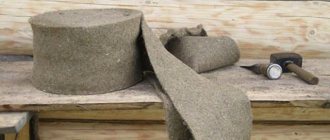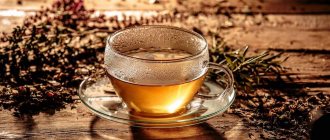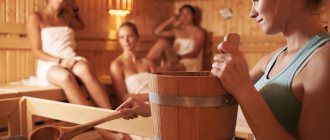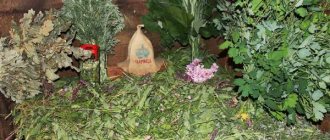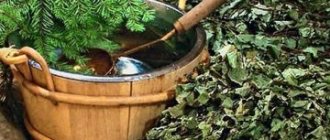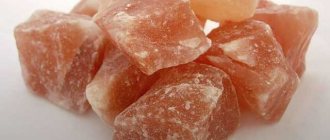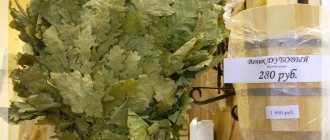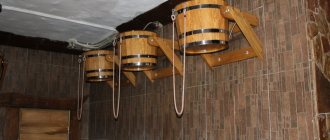admin 01/10/2018 0 Comments
SPA procedures, Aromatherapy
The bathhouse has long been a place where people came not only to wash themselves, but also to improve their health, improve their overall well-being, and get rid of stress. The main procedures in the bathhouse are warming up the body and aromatherapy with various medicinal herbs. In ancient times and today, bath brooms are made from herbs; their healing effect is enhanced with essential oils.
Various types of herbs and essential oils are used for procedures, depending on the purpose being pursued. Today, the bathhouse is not only a place for healing the body, but also, if desired, a spa salon.
Herbs for baths
Wormwood is most often used in the bath, as the herb has antiseptic properties.
It is capable of destroying many types of bacteria and harmful microorganisms when inhaling its vapors, and also helps to relax and calm the nervous system.
This plant is successfully used for the following diseases:
- Rheumatism;
- Diseases of the cardiovascular system;
- Colds.
Regular use of it in the bath will be an excellent prevention against viral and bacterial infections during the cold season. Aromatherapy in a bath with this type of herbs will improve performance and strengthen the immune system.
Another herb that is actively used in bath procedures is mint, which has a disinfectant effect, improves the functioning of the digestive tract, relieves nausea, and normalizes the functioning of the heart and lungs.
Melissa is also often used in the bath, which calms the nervous system and irritated skin, relieves tension, relaxes muscles, and has a beneficial effect on sleep.
Herbs in the steam room: how to use correctly
Depending on what effect the steamers want to achieve, herbal compositions are prepared and used for healing in the steam room. Herbal baths help and work in several directions.
- For relaxation, relieving stress and respiratory spasms. Chamomile, spruce needles, mint and thyme have a calming effect on the nervous system, making it easier for avid tobacco lovers to quit smoking.
- To raise vitality. Decoctions of tansy, jasmine, lavender, poplar buds and bison can have a clear tonic effect.
- For disinfection. Infusions of sage, thyme, mint, eucalyptus and calendula have bactericidal properties.
Read about the best time and how to properly collect herbs for medicinal purposes here.
Preparation of bath steams and brooms
Avid steamers take herbs with them to the bathhouse, pour boiling water over them and inhale their healing aroma. Greater health benefits can be achieved by using a concentrated infusion. This herbal infusion becomes an excellent alternative to synthetic essential oils. During its preparation, crushed herbs poured with boiling water are brought to a boil over a fire and simmered on it for about an hour. After filtering, the steaming is stored in a dark place for no more than 1.5-2 months. The prepared decoction of leaves and stems of plants is poured onto the heater of the bathhouse, where it instantly evaporates, leaving water vapor with a large amount of suspended substances in the air.
A bath broom is an indispensable attribute of a connoisseur of Russian baths. In the case of beneficial herbs, it is used not so much for active body massage, but to create a certain atmosphere using the aroma of the leaves. Brooms are knitted from plants of the same species or special compositions are created. Herbs collected in large bunches are hung vertically or placed on hot coals. Nettle wreaths are used for massage, after first dousing or soaking the herb in boiling water to reduce its burning properties. Bunches of mint are applied to the face to achieve a rejuvenating effect, tansy brooms are used to heal wounds and bruises.
The Russian bath creates a friendly atmosphere. It gives connoisseurs and connoisseurs of good steam not only positive emotions, but also health - strength of mind and body. Healing herbal infusions play an important role in this process.
Composition and properties of wormwood
Wormwood is one of the oldest and medicinal plants on the planet; the following components can be found in its composition:
- Natural amino acids;
- Organic acids;
- Potassium salts;
- Vitamins (A, B, C);
- Tannins;
- Minerals;
- Proteins;
- Resins;
- Bitter glycosides;
- Flavonoids;
- Alkaloids;
- Phytoncides;
- Saponins.
Thanks to such a rich composition, the use of wormwood for a bath can provide such beneficial properties as:
- Toning the body;
- Normalization of the activity of the central nervous system;
- Elimination of pain and spasms;
- Diuretic effect;
- Antifungal action;
- Anti-inflammatory effect.
Brief excerpts from the general course of botany
Probably few plants have such a strong, unique and recognizable aroma as wormwood. If you want to feel the smell of the July steppe warmed by the sun, rub a leaf of wormwood and thyme in your fingers.
This plant belongs to the Astrov family, the same one whose representatives are so widely represented in flower gardens and palisades on the outskirts of the city.
The most iconic representatives of the genus Artemisia are wormwood, common wormwood or Chernobyl, and medicinal wormwood or lemon.
Wormwood
A widely known plant with a characteristic silver color. It is one of the oldest medicinal plants and the most bitter representative of the domestic flora. It is the main component of such an iconic and controversial alcoholic drink as absinthe. The maximum concentration of nutrients in the aboveground part of this plant is observed at the beginning of flowering, in the upper shoots. When cutting, to preserve the natural color and prevent the raw material from turning brown, an important condition is quick drying, in a place protected from sunlight and well ventilated.
Wormwood actively irritates nerve endings and stimulates the production of gastric juice, which makes it a popular remedy for awakening appetite. In the Don and Kuban Cossack villages, a glass of wormwood tincture was an indispensable aperitif before any significant feast. In general, the effect of the essential composition contained in bitter wormwood on the human central nervous system is similar to camphor. In Europe, wormwood is popular as a bitter seasoning for the traditional Christmas goose, and as an important part of the recipe for another popular strong drink - vermouth.
At one time, according to the results of clinical trials, it was included in the pharmacopoeia of more than 20 countries, including the USSR. One of the well-deserved and proven qualities of this plant is its pronounced insecticidal properties. Since ancient times, in the bathhouses of the steppe region, this plant has been widely used to combat ants, fleas and cockroaches. The cut stems of the plant were simply laid out on the floor between visits to the establishment. Later, the collected plants were not thrown away, but were used in the same bathhouse to dye the fabric green.
Common wormwood
A perennial, tall herbaceous plant, with a characteristically dark-colored stem - a blade of grass, from which, in fact, it received its popular name - Chernobyl. It has a pronounced pleasant spicy aroma, which contributed to the mass production of essential oil from wormwood raw materials in Europe. Due to the content of coumarin and its derivatives in the plant, the use of oil is strictly dosed due to its toxicity. In medicine it is used as a healing, antispasmodic and diuretic. In reasonable doses it acts as a tonic.
By the way! There is an old hunting method of maintaining strength during long steppe treks, when a pinch of Chernobyl leaves was added to the hiking kulesh: both as a pronounced spice and as an equally pronounced energy stimulant.
In Zaporozhye farmsteads and winter huts, in the lower reaches of the Dnieper, Chernobyl was widely used as a seasoning for the preparation of pork hams and bacon.
By the way! Mixed with herbs, thyme is used to treat alcoholism, under the sonorous and witty name - “morning joy”.
The plant acquires the greatest strength and concentration of useful substances about a month before the seeds ripen, at which time it is harvested.
Medicinal wormwood or lemon
The stems of this plant become woody over time, almost to the top, which makes them more resistant to mechanical stress compared to their closest relatives. Lemon wormwood has the most exquisite aroma, which is very unique, and resembles some mixture of the smell of dill, pine needles and lemon. In pre-revolutionary Russia, the aerial part of this plant was used as an air freshener in public institutions.
Moreover, it should be noted that when drying, the bitterness is lost and the raw material acquires a pronounced spicy and burning taste. It goes well with various sauces that are usually served with thick, fatty meat foods. Included in the recipe as an additive to the rather exotic wormwood bread. In official medicine, this plant has not found such wide use as wormwood, and in medical practice, for the most part, it is used as a homeopathic remedy.
Types of wormwood
Science identifies approximately 400 species of this plant, and approximately 150 of them grow in Russia. In folk medicine, the following types are most often used:
- Medicinal;
- Bitter;
- Paniculata;
- Lemon.
Medicinal
This type of grass grows on roadsides, in gardens, and wastelands. Healing decoctions are made from it, which are intended to improve appetite and eliminate nervous disorders.
Gorkaya
This plant variety has a specific smell and bitter taste. It can grow anywhere, in forests, fields, meadows, cultivated soil and wild. Preparations and folk remedies containing it in their composition successfully fight epilepsy, help get rid of insomnia, depression, strengthen the immune system, destroy parasites, and treat women's diseases.
Paniculata
Paniculata blooms from July until late autumn.
In folk medicine, it is used to make wormwood brooms for baths to treat rheumatism and respiratory diseases.
In order to use the plant for medicinal purposes, only its flowers, stems and leaves should be collected.
Lemon
Lemon wormwood or abrotan has been known to people since antiquity; its healing decoction was drunk for snake bites and fever. Also, this particular type of wormwood is used to prepare seasoning; it is from it that essential oil is obtained.
Steaming a wormwood broom and steaming
Before steaming, immerse the wormwood broom in cold water for about twenty minutes, then keep it in warm water for 5-7 minutes. If the broom is made from freshly plucked branches, there is no need to steam it. To create a stronger aroma in the bathhouse, you can pour boiling water over a wormwood broom.
You need to steam with such a broom carefully, as it is very weak, except when birch or oak branches are added to the broom. Body massage with a wormwood broom is very useful.
In any case, if you are a true connoisseur of the Russian bathhouse, and going to the steam room with a birch broom has become a habit for you, do not pass by the wormwood! The benefits of a wormwood broom are undeniable, and the pleasure of soaring will be unforgettable.
Tags
broom bath broom wormwood broom health wormwood broom benefits
Indications for use
The medicinal plant is used for the following types of ailments:
- For stomach diseases;
- For fever;
- With neurasthenia;
- For parasitic infestations;
- For tuberculosis.
For stomach diseases
A herbal decoction successfully fights pain and cramps in the stomach if taken three times a day. The plant also helps cure digestive disorders, flatulence, and inflammation of the rectum. You can take it in the form of wormwood tea or alcohol tincture.
Important! A medicine made from wormwood in powder form is well suited for treating the stomach, since it is this form that penetrates into all parts of the gastrointestinal tract, including the lower ones.
For fever
For this type of disease, wormwood is used as an antipyretic.
For neurasthenia
Wormwood infusion is good for neuroses, insomnia and migraines. Baths and saunas with wormwood are also used for these purposes.
Also, a tincture of this herb in alcohol helps fight depression and improves body tone.
For parasitic infestations
When infected with worms, this herb is an indispensable, and most importantly, completely natural remedy. To destroy parasites from wormwood, cloves and tansy, a special composition is prepared, which causes the death of both adults and larvae and eggs.
Important! Despite the fact that the medicine for parasites contains only natural ingredients, it should be taken with caution, so you should consult your doctor before using it.
For tuberculosis
As an adjuvant therapy, wormwood decoction is often prescribed in the treatment of tuberculosis and other lung diseases.
Benefits and harms
The very rich composition of wormwood benefits the human body:
- good diuretic;
- has anti-inflammatory, antifungal and antiseptic effects;
- calms the central nervous system;
- charges the body with energy;
- eliminates pain and spasms.
But at the same time, if you do not consult a doctor before using wormwood, you can cause serious harm to your health. This is especially true for various tinctures and decoctions. In this case, it is extremely difficult to track how wormwood affects a person, so an overdose of wormwood may occur. Experts have long known that if you take decoctions in uncontrolled quantities, a person will develop a central nervous system disorder.
Brooms with the addition of this healing herb allow you to:
- expand the pores, in which case toxins are effectively removed from the body;
- improve blood circulation;
- light massage has a beneficial effect on the skin;
- speed up metabolism in the body;
- increase sweating.
If you use brooms made from freshly picked wormwood in the bathhouse, the effect will be more noticeable. Since tension, fatigue will be relieved, headaches will go away. Also, essential oils and phytoncides improve human performance.
Features of a wormwood broom
Each bath broom has its own characteristics, for example, one made from wormwood has a strong odor, which ensures air disinfection. But this aroma may not be to everyone’s taste; those who react sharply to various strong odors should avoid using it.
Due to the fact that wormwood is a grass, a broom made from it will be extremely fragile and can only be used once.
Experts recommend adding a few twigs of wormwood to regular classic birch brooms , so the smell will be less pronounced, the broom itself will be durable, and the beneficial effect will remain.
What herbs are used for infusions
The list of plants whose leaves, flowers or fruits are used for bath infusions is almost endless. If you try to list the weight, you will get a voluminous book (and such a book probably exists). The most common and famous are the following plants and herbs: eucalyptus, juniper, birch, hawthorn, linden, thyme, coltsfoot, motherwort, calendula, yarrow, caraway, St. John's wort, oregano, sage, rowan, oak bark, sweet clover, chamomile, wormwood, lavender, etc.
Each of them can be used separately, but more often they are used in the form of mixtures in various combinations. Species with approximately the same medicinal properties are purposefully selected, trying to obtain a greater total effect than from each component separately. Combinations of herbs with opposite effects on the body, for example, a calming and tonic effect (St. John's wort with wormwood, oregano with cumin, etc.) are excluded. And for the rest - the widest opportunities for your creativity, testing various combinations and proportions, taking into account both medicinal and aromatic properties that are pleasant to you personally.
When to harvest wormwood for brooms
Most people know how to use wormwood in a bath, but not everyone knows when to collect it in order to make a broom. Suitable types of herbs for making brooms include paniculata, bitter, lemon, and medicinal.
You should start making a broom when the plant has finished flowering. The timing of its flowering varies for each species, the approximate period being from July to October. The grass should be collected before it has time to dry; it should be dried in a cool, dark place.
What are the benefits of wormwood?
Since ancient times, wormwood has been especially valued for its unique healing properties. After all, even the name itself is literally translated from ancient Greek as “health.”
This plant, releasing its characteristic aromas in the room, disinfects the air, so our ancestors used wormwood smoke to fumigate houses, especially in those days when a deadly epidemic was raging. Several varieties of wormwood are found in nature. One type is prescribed for nervousness and irritability, another for relieving headaches, a third for cleansing the body, and so on.
Wormwood steaming and sauna decoction
The benefits of wormwood in the bath are also possible when using steaming and decoctions from it. Parking is very easy to do:
- The collected herbs are poured with boiling water and left for about two hours before going to the bathhouse.
- Next, the broth is filtered and poured onto the heater. You should ensure that the steaming does not contain any impurities from the leaves, which will burn after drying.
To achieve greater effect, experts at https://lisaekb.com/ advise steaming fresh herbs.
How do decoctions work?
Decoctions perform a healing function. Their steam has a beneficial effect on the body's condition. Has an effect:
- tonic;
- soothing;
- hypotensive;
- anti-inflammatory;
- bactericidal;
- expectorant;
- restorative.
When selecting herbs for preparing a healing decoction, you need to know what properties a particular plant has.
Pine decoctions have a pronounced calming effect. Steam, saturated with the aroma of pine or spruce needles, will help relieve the feeling of overwork. You can take essential oil (cedar or fir) into the bathhouse if it is not possible to make a decoction from fresh raw materials. Just add a few drops of oil to a ladle of water and splash it on the heated stones.
Chamomile is known as a universal medicinal plant. The steam from its decoction also has a complex effect on the body:
- diaphoretic;
- anti-inflammatory;
- antiseptic.
Another plant with unique properties is linden. A decoction is made from its flowers to help cure colds. Linden steam acts as a diaphoretic.
Currant and horseradish leaves are also effective against colds.
For the health of the cardiovascular system, it is useful to use eucalyptus and mint in the bath.
Oregano, thyme and lavender are useful for diseases of the respiratory system.
The benefits of wormwood in the bath are also possible when using steaming and decoctions from it. Parking is very easy to do:
- The collected herbs are poured with boiling water and left for about two hours before going to the bathhouse.
- Next, the broth is filtered and poured onto the heater. You should ensure that the steaming does not contain any impurities from the leaves, which will burn after drying.
To achieve greater effect, experts advise steaming fresh herbs.
In order for bath herbs to act more effectively, infusions and decoctions must be prepared correctly.
The raw materials from which herbal infusions for the bath will be prepared must be thoroughly dried in a room deprived of sunlight, well ventilated and dry.
After drying, the raw materials are crushed. The fruits and seeds need to be crushed until they resemble semolina. The size of crushed leaves and flowers should not exceed 0.5 cm, and the size of bark, stems and roots - 0.3 cm. Some recipes suggest preparing an infusion from whole parts of the plant.
Raw materials, placed in a tightly sealed container, should be stored in dark and cool conditions. It is better to place different plants in separate jars. Before preparing the infusion, the components can be mixed in the required proportions. It is advisable that the dishes have a mark on the time of collection of raw materials, since leaves, flowers and herbs are stored for no more than 2 years. Berries and fruits retain their beneficial properties for about 4 years.
Before infusion, it is better to place the crushed herbs for the bath in a gauze bag. Then it is immersed in a container of hot water for 30 minutes. Some compositions can be infused for several hours.
The decoction is prepared as follows:
- About 100 g of a mixture of medicinal herbs should be placed in an enamel or stainless steel container.
- Pour 4 liters of boiling water into a saucepan.
- The dish, covered with a lid, should be placed on low heat. The mixture should cook for 5-10 minutes.
- After cooling in a closed pan, the broth is filtered through doubled gauze.
It is very easy to prepare infusions for the bath, the component of which is thyme. The simplest recipe suggests brewing several stems of grass in a glass of boiling water. After 30 minutes, the infusion is filtered through cheesecloth. Now you can add a few drops of eucalyptus oil to it.
Plant materials for infusion are taken in equal proportions. 15 g of the mixture is poured into 200 ml of boiling water. Infusion time – 4 hours.
It is useful to use an infusion of pine, spruce or fir branches in bath procedures. It is prepared like this:
- branches are cut finely;
- 5 glasses of raw materials are poured into a bucket of hot water;
- the infusion is brewed for 30 minutes.
Pine infusion:
- good for the nervous system;
- reduces symptoms characteristic of menopausal syndrome in women;
- helps fight diseases of the urinary system.
People with weakened immune systems are recommended to steam in a steam room filled with the aroma of horseradish leaves. The infusion is prepared from fresh or dried raw materials. Several leaves of the plant are brewed in a bucket filled with boiling water for 30 minutes. For those with a cold, steam will help to quickly cope with the disease.
Contraindications
The benefits and harms of wormwood in the bath have long been one of the most discussed issues. Taking a steam bath using this plant is not recommended for pregnant and lactating women, those people who suffer from asthma, stomach ulcers, anemia, or who are allergic to this herb.
They should also refrain from taking medications with this plant. Wormwood is a fairly useful whole plant and can help cure many diseases, but it also has a specific smell and some restrictions on taking medicines from it and bathing procedures using it.
In order for therapy with this herb to be successful and not cause side effects, proportions and dosages must be observed when preparing various potions from it.
← Previous material
Next material →
MY TEA RECIPE FOR WELL-BEING
With the arrival of autumn and winter, we are overcome by depression, sadness and apathy. And all because of a lack of serotonin - the happiness hormone responsible for good mood and emotional stability. During this period, our body is most susceptible to various viruses that cause diseases. The reason is decreased immunity. Herbal tea will help you cope with all this. And it is not at all necessary to buy it at the pharmacy. You can prepare a healing drink yourself.
When there are signs of illness, we rush to the pharmacy with medicine. And, of course, we give preference to herbal products. After reading the instructions, we understand that they contain common plants that grow in our meadows and forests or even in our garden.
For myself, I selected herbs for tea that would strengthen the immune system, cleanse blood vessels, remove toxins, lower blood pressure, calm the nervous system and at the same time have a pleasant aroma.
The composition was as follows: mint, lemon balm, thyme, calendula flowers, chicory flowers, marshmallow flowers, echinacea flowers and leaves, Jerusalem artichoke flowers and leaves, agrimony, corn silk, chamomile.
Mint
– a medicinal plant with a pronounced aroma. Mint infusions relieve headaches, stimulate cardiac activity, relieve stomach and intestinal colic, and calm the nervous system. I collect mint before it blooms, mostly using the leaves and stems.
Melissa
It has a delicate aroma, invigorates and strengthens the entire body as a whole. It is advisable to collect it before flowering. After drying, the herb should be immediately placed in a tightly sealed container.
Thyme decoction
relieves fatigue, strengthens the body as a whole, improves well-being and metabolism, helps with insomnia, and has a beneficial effect on the nervous system. I collect thyme during flowering.
Calendula
has a beneficial effect on the functioning of the heart, lowering blood pressure and strengthening blood vessels. It has a general strengthening effect on the entire body and has bactericidal properties. I collect blooming calendula flowers, they contain the most useful substances.
Chicory
increases the body's defenses, normalizes metabolism, has a beneficial effect on the nervous system, and enhances cardiac activity. I collect chicory flowers early in the morning; in the afternoon they may wilt and lose some of their medicinal properties.
For tea for preventive purposes I use pale pink marshmallow
. They have a calming effect on the gastrointestinal tract.
Echinacea
activates the body's defenses, helps fight viruses, normalizes blood pressure, relieves fatigue, strengthens memory and improves vision, improves mood and performance. I prepare the plant during flowering.
Jerusalem artichoke leaves and inflorescences
increase immunity, remove cholesterol, prevent atherosclerosis, regulate blood sugar levels. I collect young leaves long before the plant blooms, and flowers as soon as they bloom.
Agrimony
used as an astringent and disinfectant for indigestion, poisoning, infectious diseases of the gastrointestinal tract, bleeding and hemorrhoids. I collect agrimony during flowering and prepare a stem with leaves and flowers.
Corn silk
contain a complex of biologically active elements in their natural form and are used as a general strengthening and preventive agent.
A chamomile drink helps with poor health and fatigue. Drink a glass of chamomile tea at night and you will forget about insomnia. I collect chamomile during flowering, in dry, windless weather, and dry it in the shade to preserve all the healing substances.
When all the herbs have been collected and dried, I put them on a clean table, knead them with my hands and mix them so that each teaspoon of dry raw materials contains all the ingredients of the herbal collection. I brew it like regular tea (2-3 teaspoons of dry raw materials per glass of water) or add it to my usual black or green tea (1 teaspoon of herbal tea and a little less tea leaves than usual). I leave it for about 10 minutes and drink it only fresh. It is advisable to prepare such a collection for the winter and use it during the period when our body is most susceptible to viral infections.
To enhance the healing effect of visiting the steam room, many use medicinal herbs for the bath: by collecting and drying the plants with our own hands, we obtain a material that is unique in its properties.
Even if you focus on those species that grow only in our area, you can put together a good green first aid kit. Well, there are many ways to use these herbs, and we will talk about the most popular ones in the article below.
The best products for the steam room
There are several oils that can be used in the bath.
Eucalyptus
The main active ingredient of the product is cineole. This substance has antiviral and antibacterial properties. Helps get rid of colds and improves the condition of the respiratory system.
Eucalyptus essential oil
Thyme oil
This remedy has sedative properties. It calms, helps to relax, normalizes sleep. Has a positive effect on the nervous system. Regular use of thyme oil helps get rid of insomnia.
Eucalyptus essential oil
Lavender
This product is soothing and helps you relax. Helps cleanse the epidermis of acne and other rashes. Normalizes the activity of the sebaceous glands.
Lavender essential oil
Cypress
This remedy is recommended for people suffering from pathologies of the respiratory system. It has mucolytic properties. Helps remove mucus from the lungs and relieves runny nose. Improves the condition of mucous membranes. Cypress oil also has the following properties:
- normalizes hormone levels;
- improves metabolism;
- has a positive effect on the nervous system;
- relieves symptoms of menopause.
Essential oil "Cypress"
Sosnovoe
One of the most useful products. The product affects the body as follows:
- cleanses the epidermis of rashes, including pathological ones;
- helps get rid of diseases of the respiratory system;
- cures runny nose, sinusitis;
- improves the condition of the heart and blood vessels;
- promotes recovery after a heart attack;
- increases potency in men.
Pine oil
Melissa oil
Another useful product that gives this effect:
- tones;
- increases the body's defenses;
- has a positive effect on the state of the cardiovascular system;
- improves reproductive function in women;
- promotes rejuvenation.
Melissa oil
Other oils
Other oils listed in the tables can also be used in the sauna.
Table 1. Essential oils for sauna with medical effect:
| Oil name | Action |
| Juniper, anise, dill | They have mucolytic properties. Helps get rid of coughs, including old ones |
| Tea tree, mint, bergamot, lemon, rosemary | Relieves headaches. Stabilizes blood pressure |
| Wormwood, Chinese lemongrass | Tones up, has a positive effect on the nervous system, helps cope with stress |
| Valerian, chamomile, sea buckthorn, sage | Helps cope with pathologies of the epidermis - psoriasis, dermatitis, etc. |
| Fir, spruce, cedar | They stop inflammatory processes, destroy harmful microorganisms, and promote cell regeneration. Used for pathologies of the epidermis |
| Sandalwood, juniper | They rid the body of waste and toxins, promote sweating, which helps get rid of excess weight. |
| Sage | Increases the body's defenses |
| Eucalyptus, lemon balm | Remove excess fluid from the body. Promotes the convergence of edema |
Essential oils for sauna with medical effect
Table 2. Essential oils for sauna with cosmetic effect:
| Oil name | Action |
| Orange, lemon, grapefruit | They have fat burning properties. This allows you to get rid of extra pounds. Improves the condition of the epidermis |
| Santal, rosemary, patchouli | They have a positive effect on the condition of the skin and hair. Helps get rid of dandruff |
| Shalea, lavender | Improves the action of the sebaceous glands. Relieves excessive oiliness of the epidermis and hair |
| Juniper, roses | Promote rejuvenation |
| Neroli, patchouli | Moisturizes the skin and helps retain moisture inside. Used for dry epidermis |
Essential oils for sauna with cosmetic effect
Table 3. Essential oils for sauna with aromatherapy effect:
| Oil name | Action |
| Vanilla, sandalwood, ylang-ylang | Increase libido |
| Geranium, rosemary | Increases performance, improves memory, stimulates brain function |
| Grapefruit | Tones |
| Fir, cedar | Improves mood and helps cope with stressful situations |
| Orange, jasmine | Relieves insomnia, improves mood, quality and duration of sleep |
Essential oils for sauna with aromatherapy effect
Essential oils for sauna
Infusions, decoctions, cocktails
Infusions and decoctions are water extracts from medicinal plants. Cocktails are more complex infusions of aromatic herbs that are used in the steam room.
Please note that all decoctions, infusions and cocktails are medicine, so when selecting ingredients it is necessary not to harm the body
It is necessary to know exactly the purpose: a pleasant aroma or treatment? And if treatment, then what?
If you buy herbs at a pharmacy, check the expiration date on the packaging.
The reasonable amount of decoction or infusion that is added to hot water in a bath is determined individually by everyone, but, as a rule, 50 ml of strong decoction/infusion per 2 liters of hot water is needed.
As for the cocktail, it is a concentrate of various infusions. The total amount of any cocktail is about 50 g of herbs per 2 liters of hot water.
Pushkin also wrote in “Ruslan and Lyudmila” about the method of fanning steaming branches. This method is still good today. An infusion or decoction is sprinkled onto the twigs (option: flax fans).
While taking a sauna, you fan yourself with them. Thus, the heat shock is combined with the aromatic one, doubling the benefits, healing effect and overall pleasure of the procedure.
Or you can simply spray the concentrated decoction, infusion or cocktail with a regular spray bottle.
How to prepare an herbal infusion?
Preparation of infusion in a cold way
Place the crushed plant in a porcelain, glass or enamel (no chips!) dish, fill it with the required amount of cold boiled water (or thawed water at room temperature), cover with a lid, leave for 4-12 hours and filter.
Preparing the infusion using the hot method
Fill the grass with water. Place the dishes in a boiling water bath and heat for 15 minutes.
A water bath is a prerequisite for preparation, since with this method the medicinal plant simmers, but does not boil.
After this, cool the infusion and filter through cheesecloth.
How to prepare a herbal decoction?
Place the crushed plant in an enamel, porcelain or container, fill it with freshly boiled water (1-2 tablespoons per glass of boiling water, that is, 1:10 or 1:20).
Then cover this container with a lid and place it in a pan of boiling water.
Simmer for 30 minutes, stirring regularly, then leave to cool slowly for 45 minutes.
After this we filter. Our decoction is ready.
You can make a decoction in another way: pour chopped medicinal roots and leaves with boiled water at room temperature.
Let it brew for 5-7 hours. After this, boil for 10-15 minutes or keep in a water bath for thirty minutes.
An important condition in order for all valuable properties to be preserved is to avoid direct sunlight.
Dry herbs and roots for the steam room
You can also flavor the sauna in this way: while walking, pick up pine or spruce branches, you can pick a bouquet of wormwood, lilac, collect leaves of eucalyptus, black currant, sage, cherry, linden.
Bring them home, and before taking a sauna, immerse them in not too hot water for 8-12 minutes.
Then take them out and place them in a heated sauna.
After just 1-2 minutes you will feel a slightly intoxicating scent.
But don’t try to try all the scent methods at once in one go.
Remember - joint action is unpredictable.
Have a pleasant and relaxing holiday!
Do you know how else you can use decoctions, infusions, tinctures?

